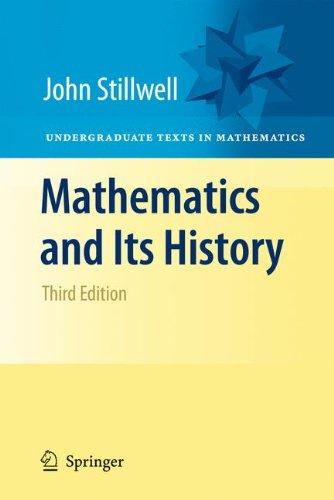Copies of the classnotes are on the internet in PDF format as given below. The notes and supplements may contain hyperlinks to posted webpages; the links appear in red fonts. The "Examples, Exercises, and Proofs" files were prepared in Beamer. The "Printout of Examples, Exercises, and Proofs" are printable PDF files of the Beamer slides without the pauses. These notes have not been classroom tested and may have typographical errors.
The catalog description for History of Mathematics is: "A study of mathematics and those who contributed to its development. Recommended for teachers and those desiring to expand their view of mathematics." The prerequisites are Linear Algebra (MATH 2010), Calculus 3 (MATH 2110), and Mathematical Reasoning (MATH 3000).
1. The Theorem of Pythagoras.
- 1.1. Arithmetic and Geometry.
- 1.2. Pythagorean Triples.
- 1.3. Rational Points on the Circle.
- 1.4. Right-Angled Triangles.
- 1.5. Irrational Numbers.
- 1.6. The Definition of Distance.
- 1.7. Biographical Notes: Pythagoras.
2. Greek Geometry.
- 2.1. The Deductive Method.
- 2.2. The Regular Polyhedra.
- 2.3. Ruler and Compass Constructions.
- 2.4. Conic Sections.
- 2.5. Higer-Degree Curves.
- 2.6. Biographical Notes: Euclid.
3. Greek Number Theory.
- 3.1. The Role of Number Theory.
- 3.2. Polygonal, Prime, and Perfect Numbers.
- 3.3. The Euclidean Algorithm.
- 3.4. Pell's Equation.
- 3.5. The Chord and Tangent Methods.
- 3.6. Biographical otes: Diophantus.
4. Infinity in Greek Mathematics.
- 4.1. Fear of Infinity.
- 4.2. Eudoxus's Theory of Proportions.
- 4.3. The Method of Exhaustion.
- 4.4. The Area of a Parabolic Segment.
- 4.5. Biograpical Notes: Archimedes.
5. Number Theory in Asia.
- 5.1. The Euclidean Algorithm.
- 5.2. The Chinese Remainder Theorem.
- 5.3. Linear Diophantine Equations.
- 5.4. Pell's Equation in Brahmagupta.
- 5.5. Pell's Equation in Bhaskara II.
- 5.6. Rational Triangles.
- 5.7. Biographical Notes: Brahmagupta and Bhaskara.
6. Polynomial Equations.
- 6.1. Algebra.
- 6.2. Linear Equations and Elimination.
- 6.3. Quadratic Equations.
- 6.4. Quadratic Irrationals.
- 6.5. The Solution of the Cubic.
- 6.6. Angle Division.
- 6.7. Higher-Degree Equations.
- 6.8. Biographical Notes: Tartaglia, Cardano, and Viete.
7. Analytic Geometry.
- 7.1. Steps Toward Analytic Geometry.
- 7.2. Fermat and Descartes.
- 7.3. Algebraic Curves.
- 7.4. Newton's Classification of Cubics.
- 7.5. Construction of Equations, Bezout's Theorem.
- 7.6. The Arithmetrization of Geometry.
- 7.7. Biographical Notes: Descartes.
9. Calculus.
- 9.1. What Is Calculus?.
- 9.2. Early Results on Areas and Volumes.
- 9.3. Maxima, Minima, and Tangents.
- 9.4. The Arithmetica Infinitorum of Wallis.
- 9.5. Newton's Calculus of Series.
- 9.6. The Calculus of Leibniz.
- 9.7. Biographical Notes: Wallis, Newton, and Leibniz.
14. Complex Numbers in Algebra.
- 14.1. Impossible Numbers.
- 14.2. Quadratic Equations.
- 14.3. Cubic Equations.
- 14.4. Wallis's Attempt at Geometric Representation.
- 14.5. Angle Division.
- 14.6. The Fundamental Theorem of Algebra.
- 14.7. Proofs of d'Alembert and Gauss.
- 14.8. Biographical Notes: d'Alembert.
16. Complex Numbers and Functions.
- 16.1. Complex Functions.
- 16.2. Conformal Mappings.
- 16.3. Cauchy's Theorem.
- 16.4. Double Periodicity of Elliptic Functions.
- 16.5. Elliptic Curves.
- 16.6. Uniformization.
- 16.7. Biographical Notes: Lagrange and Cauchy.
18. Non-Euclidean Geometry.
- 18.1. The Parallel Axiom.
- 18.2. Spherical Geometry.
- 18.3. Geometry of Bolyai and Lobachevsky.
- 18.4. Beltrami's Projective Model.
- 18.5. Beltrami's Conformal Models.
- 18.6. The Complex Interpretations.
- 18.7. Biographical Notes: Bolyai and Lobachevsky.
19. Group Theory.
- 19.1. The Group Concept.
- 19.2. Subgroups and Quotients.
- 19.3. Permutations and Theory of Equations.
- 19.4. Permutation Groups.
- 19.5. Polyhedral Groups.
- 19.6. Groups and Geometries.
- 19.7. Combinatorial Group Theory.
- 19.8. Finite Simple Groups.
- 19.9. Biographical Notes: Galois.
Additional Chapters and Appendices.
- Chapter 8. Projective Geometry.
- Chapter 10. Infinite Series.
- Chapter 11. The Number Theory of Revival.
- Chapter 12. Elliptic Functions.
- Chapter 13. Mechanics.
- Chapter 15. Complex Numbers and Curves.
- Chapter 20. Hypercomplex Numbers.
- Chapter 21. Algebraic Number Theory.
- Chapter 22. Topology.
- Chapter 23. Simple Groups.
- Chapter 24. Sets, Logic, and Computation.
- Chapter 25. Combinatorics.
Return to
Bob Gardner's home page

